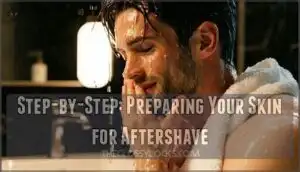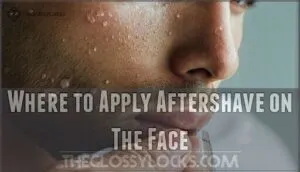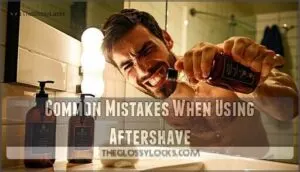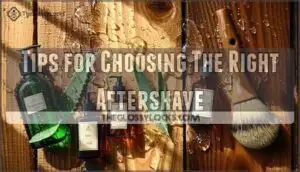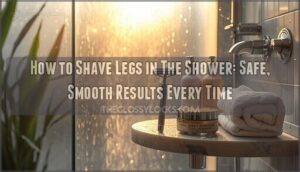This site is supported by our readers. We may earn a commission, at no cost to you, if you purchase through links.
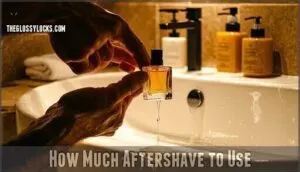 The right amount of aftershave depends on the product type—most men need just a dime-sized portion for splashes and lotions or a nickel-sized amount for balms to cover the entire shaved area. Applying too much won’t give you better results; it’ll just leave your skin greasy or irritated while wasting product.
The right amount of aftershave depends on the product type—most men need just a dime-sized portion for splashes and lotions or a nickel-sized amount for balms to cover the entire shaved area. Applying too much won’t give you better results; it’ll just leave your skin greasy or irritated while wasting product.
The key is understanding that aftershave works through absorption, not saturation, so less is genuinely more regarding post-shave care. Your skin type also plays a role—oily skin absorbs less, while dry or sensitive skin drinks up moisture-rich formulas faster.
Getting the dosage right transforms aftershave from a stinging ritual into a soothing finish that closes pores, prevents bacteria, and leaves you looking sharp.
Table Of Contents
Key Takeaways
- You only need a dime-sized amount for splashes and lotions or a nickel-sized portion for balms to cover your entire shaved area, since aftershave works through absorption rather than saturation.
- Your skin type dictates the exact quantity—oily skin needs less product to avoid shine and breakouts, while dry skin can handle more to lock in hydration, and sensitive skin works best with just a few drops of alcohol-free formulas.
- Proper application technique matters as much as quantity: always apply aftershave to clean, damp skin immediately after shaving, pat rather than rub, and wait five minutes before layering cologne to prevent fragrance clashes and skin irritation.
- Most aftershaves expire over time as alcohol evaporates and ingredients break down, so watch for changes in scent, color, or texture that signal reduced effectiveness.
What is Aftershave and Why Use It?
Aftershave does more than just smell good—it’s built to calm and protect your skin right after you shave.
Before you pour it on, it helps to know what it actually does and how it’s different from regular cologne.
Key Benefits for Post-Shave Skin
After dragging a razor across your face, your skin isn’t just smooth—it’s vulnerable, stripped of its natural oils, and calling out for relief that only the right aftershave can deliver.
Aftershave does more than just smell good—it’s a critical step in post-shave care. Quality formulas offer:
- Pore Closure: Astringents tighten skin, minimizing pore exposure
- Bacteria Prevention: Antiseptic ingredients combat infection risks
- Redness Reduction: Anti-inflammatory agents calm visible irritation
- Irritation Soothing: Healing compounds ease razor burn discomfort
- Skin Hydration: Moisturizing elements restore balance after shaving
Proper skincare after shaving protects your face while promoting healthy recovery.
Differences Between Aftershave and Cologne
Many people confuse aftershave with cologne, but they serve different roles in your grooming lineup. Aftershave contains 1–3% aromatic compounds and focuses on skin benefits—soothing irritation, preventing infection, and closing pores with antiseptics like witch hazel. Cologne packs 2–5% fragrance oils for scent longevity, lasting 2–3 hours compared to aftershave’s one-hour fade.
As the term "cologne" originated in Cologne, Germany, it’s worth pointing out that Eau de Cologne refers to a specific type of perfume with a lower concentration. Here’s how they compare:
| Feature | Aftershave | Cologne |
|---|---|---|
| Primary Purpose | Soothes post-shave skin, prevents infection | Provides lasting fragrance |
| Scent Duration | ~1 hour | 2–3 hours |
| Ingredient Composition | Antiseptics, moisturizers, cooling agents | Higher fragrance concentration, fewer skin-repair elements |
Application timing matters too. Don’t apply cologne immediately after shaving—alcohol-rich formulas sting vulnerable skin. Apply aftershave first, wait 5–10 minutes, then layer cologne on pulse points. This approach respects each product’s strengths while avoiding fragrance clashes.
Knowing these distinctions and which aftershave types suit your skin lets you make better choices for your daily routine.
Most men today lean toward balms instead of splashes—a shift that shows how skin health is becoming just as important as smelling good.
How Much Aftershave Should You Use?
Getting the amount right makes all the difference between soothed skin and wasted product.
The ideal quantity depends on your aftershave type, your skin’s unique needs, and how much your skin actually absorbs.
Recommended Amounts by Product Type
The right amount of aftershave depends entirely on which type you’re using—and the difference between a splash, balm, gel, or lotion isn’t just texture.
Aftershave splashes require 3–5 ml due to higher alcohol content, while balms work best at a dime-sized portion, roughly 2–3 ml. Gels follow similar balm dosage guidelines, absorbing quickly without residue.
Lotions and creams demand careful application—start small and add more if needed to avoid overwhelming your skin.
Adjusting Quantity for Skin Type (Oily, Dry, Sensitive)
Your skin type determines the ideal amount of aftershave to use. If you have oily skin, a pea-sized amount (approximately 1 ml) is sufficient to avoid excess shine and breakouts. For dry skin, a more generous application of around 4 ml helps lock in much-needed hydration.
Seasonal adjustments are also important. Oily skin requires 30% less product during the summer months, while dry skin craves additional moisture in winter.
If you have sensitive skin, a lighter approach is necessary:
- Use only two to three drops for full coverage
- Choose alcohol-free, fragrance-free options
- Apply with gentle patting instead of rubbing
Using the correct skincare quantities is essential for maximizing the efficacy of your products and maintaining overall skin health.
Skin Absorption and Retention Factors
How much cologne you apply matters, but skin barrier function is what really determines how much sticks around.
Your skin’s outer layer acts as a gatekeeper—lipid-soluble ingredients slip through 50% faster than water-based ones. Molecular weight plays a role here too: molecules under 500 Daltons get absorbed easily, while bigger compounds can’t penetrate as well.
Beyond how much you apply, skin barrier function largely controls what stays put. Your skin’s outermost layer blocks absorption—lipid-soluble ingredients penetrate 50% faster than water-based ones. Ingredient molecular weight matters too: molecules under 500 Daltons absorb best, while larger compounds struggle to break through.
Dry skin absorbs faster but holds scent shorter, while oily skin types retain fragrance longer thanks to sebum. Hydrated skin extends retention by 25%, so moisturize skin right after shaving when pores are open. Damaged barriers from nicks increase absorption 20–30%, affecting how your skin hydration and care routine performs overall.
| Factor | Impact on Absorption |
|---|---|
| Skin pH impact | Acidic pH (4.5–5.5) stabilizes retention; alkaline shifts boost penetration by 30% |
| Product formulation | Microemulsions improve penetration 35% over standard lotions |
| Application technique | Patting on damp skin increases absorption; spray methods lose 77% to air |
Step-by-Step: Preparing Your Skin for Aftershave
Getting your skin ready for aftershave isn’t complicated, but doing it right makes all the difference in how well the product works.
Here’s what you need to do before you apply anything to your freshly shaved face.
Importance of Clean, Damp Skin
Think of your freshly shaved skin like a door left wide open—clean, damp skin doesn’t just welcome aftershave, it practically rolls out the red carpet for peak absorption and effectiveness. When you’re applying aftershave correctly, moisture on your skin acts as a delivery system, boosting absorption efficiency and helping those soothing ingredients penetrate deeper for better shaving irritation relief.
Proper pore preparation makes all the difference:
- Residue removal prevents blockage – Leftover shaving cream or oils create barriers that reduce skin hydration and care
- Hydration levels heighten benefits of aftershave – Damp skin absorbs active ingredients faster than bone-dry surfaces
- Clean application reduces skin sensitivity – Debris-free pores mean less irritation and better skin care after shaving
- Clean application reduces skin sensitivity – Debris-free pores mean less irritation and better skin care after shaving
Showering and Shaving Preparation
Before you even pick up your razor, your shower routine can make or break your entire shaving experience—and the effectiveness of whatever aftershave you choose. Hot water softens facial hair and opens pores, making your skin preparation ideal for a smoother shave.
Pre-shave exfoliation removes dead skin cells that can clog your blade, while the right shower temperature—warm, not scalding—gets your skin ready for shaving cream choice and blade preparation, ultimately delivering better shaving irritation relief.
Removing Residue Before Application
After all that careful prep work, you’d be surprised how many guys sabotage their shave by skipping one key step: rinsing away every trace of shaving cream, gel, or oil left on their face.
If there’s any leftover product sitting on your face, it forms a barrier that blocks your aftershave from doing its job.
This cleansing importance can’t be overstated: leftover product creates a barrier between your skin and the soothing benefits of your skin care routine.
How to Apply Aftershave Correctly
Once you’ve got your skin prepped and ready, the next step is knowing how to actually put the aftershave on.
The technique you use and where you apply it can make all the difference in how your skin feels afterward.
Application Techniques for Each Type
Each type of aftershave demands its own technique—splashes need a light touch, while balms work best when warmed and pressed into your skin. For splashes, pat gently with your fingertips to control absorption time and avoid stinging. Balms require light application pressure—rub between your palms first, then press into damp skin using upward motions.
Gels spread easily with fingertips, perfect for incorporating aftershave routine without heaviness.
These fragrance application techniques prevent product combinations from clashing when layering techniques matter most.
Where to Apply Aftershave on The Face
Your shaving zones—cheeks, jawline, neck, and upper lip—need coverage, but you shouldn’t treat your face like you’re painting a fence. Follow your shaving direction for even distribution, working from cheeks downward while avoiding the eye area entirely.
Sensitive areas like your neck require gentler pressure during application.
Stick to this method, and you’ll get proper postshave care without wasting product. Before long, reaching for aftershave becomes automatic—just another simple step in your facial care routine.
This application order in your shaving routine ensures proper postshave care without waste, making incorporating aftershave routine second nature when using facial care products for men.
Common Mistakes When Using Aftershave
Even when you’re trying to do everything right, it’s easy to slip up with aftershave application.
Let’s look at the most common pitfalls and how to avoid them so your skin gets the care it deserves.
Overapplication and Its Effects
When you splash on too much aftershave, you’re not just risking funny looks—you’re inviting real trouble. Overapplication can trigger skin irritation, allergic reactions, and even respiratory effects in those around you.
Studies show that nearly 20% of people experience adverse health issues from overexposed fragrance products, while systemic absorption of alcohol-based formulas can disrupt your skin’s natural oxidation field by roughly 140%, weakening its protective barrier against environmental pollutants.
Using The Wrong Product for Your Skin
Using the wrong aftershave for your skin type is like wearing boots to the beach—uncomfortable now, painful later.
When your product doesn’t match your complexion, you’re setting yourself up for irritation instead of relief:
Picking the wrong aftershave for your skin is like wearing boots to the beach—it just doesn’t work, and you’ll pay for it later. Here’s how skin type mismatch causes more irritation than benefit:
- Alcohol-based splashes dry out sensitive skin, triggering allergic reactions and long-term barrier damage.
- Heavy balms clog oily skin types, creating breakouts instead of protection.
- Fragrance-heavy formulas inflame product ingredient sensitivity, especially on reactive complexions.
- Wrong hydration levels leave dry skin parched or oily skin greasy.
- Ignoring ingredient lists when choosing the right aftershave guarantees skin irritation down the road.
Types of aftershave products matter—match them to your needs.
Fragrance Layering Pitfalls
Mixing aftershave with cologne or other scented products turns your face into a fragrance battlefield where nothing smells right and everything clashes. Here’s what goes wrong with poor fragrance layering:
| Layering Pitfall | What Happens | The Fix |
|---|---|---|
| Scent clash | Competing fragrances create unpleasant chemical reactions on your skin | Stick to one signature scent or use unscented aftershave |
| Overshadowing scents | Heavy cologne drowns out your aftershave’s subtle notes entirely | Apply aftershave first, wait 5 minutes before fragrance application |
| Projection problems | Layering grooming products amplifies scent intensity beyond comfortable levels | Use alcohol-free balms under cologne to control projection |
| Longevity issues | Incompatible formulas cancel each other out, fading faster than expected | Match fragrance families—woody with woody, fresh with fresh |
| Skin sensitivity | Multiple alcohol-based products irritate and dry out facial skin | Choose one hydrating product and layer fragrance on pulse points instead |
Follow these fragrance application tips to avoid turning your grooming routine into a nose-wrinkling disaster.
Tips for Choosing The Right Aftershave
Choosing the right aftershave isn’t just about grabbing the first bottle you see—it’s about matching the product to what your skin actually needs.
Here’s how to find an aftershave that works with your routine and keeps your face feeling its best.
Matching Aftershave to Your Skin Needs
Finding the right aftershave isn’t about grabbing the first bottle with a nice scent—it’s about understanding what your skin actually needs after you’ve dragged a blade across it.
If you’ve got oily skin, look for lightweight lotions or alcohol-based splashes that won’t add extra shine.
Dry or sensitive skin types need aftershave balms packed with hydrating ingredients for serious skin protection and moisture retention.
Ingredient Considerations (Alcohol, Witch Hazel, Essential Oils)
Alcohol content in your aftershave isn’t something you should gloss over. Most commercial formulas pack 40–70% alcohol, with certain brands pushing that number up to 84%—great for killing bacteria, but potentially harsh on skin that’s already irritated from shaving.
Here’s what to watch for:
When you’re scanning ingredient labels, alcohol content matters more than you might think. Commercial aftershaves commonly contain 40–70% alcohol, with some formulations reaching 84%, which delivers strong antiseptic benefits but can dry out or irritate sensitive skin. Here’s what to watch for:
- Alcohol sensitivity: Choose alcohol-free or low-alcohol options if you experience redness or stinging after application
- Witch hazel benefits: This natural astringent reduces inflammation and irritation, used in a standard concentration of 1.8% in modern formulations
- Essential oil limits: Stick to products with 1–3% essential oils for antiseptic ingredients like tea tree or lavender
- Allergen risks: Fragrances and preservatives cause reactions in some users, so patch-test new products first
- Ingredient transparency: Look for brands that clearly list concentrations to avoid surprises
Balancing effectiveness with skin comfort means knowing what’s actually in that bottle.
Integrating Aftershave Into Your Grooming Routine
Once you’ve got your aftershave picked out, the real trick is weaving it into your daily routine so it actually becomes second nature instead of something you forget half the time. Apply aftershave immediately after rinsing post-shave to lock in moisture and get the most skin benefits.
Pair it with your skincare routine—think moisturizer and sunscreen—for complete skincare that targets long-term benefits like reduced irritation and healthier skin.
Adjust your grooming routine seasonally: lighter balms in summer, richer creams in winter. If you’re layering scent pairing with cologne, wait five minutes between applications for ideal routine customization.
Frequently Asked Questions (FAQs)
Can aftershave expire or lose effectiveness?
Yes, aftershave does expire. Over time, alcohol evaporates, antiseptic ingredients lose potency, and natural ingredients break down, especially with poor storage conditions.
Watch for changes in scent, color, or texture—these are signs your aftershave’s effectiveness has declined.
Should you refrigerate aftershave for better results?
Keeping your cool? Refrigerating aftershave isn’t necessary for effectiveness, but it can improve your sensory experience. Cold aftershave delivers soothing relief to irritation and mimics the calming effect of cold water on freshly shaved skin.
However, extreme cold may affect ingredient stability over time. If you have sensitive skin, chilled aftershave—especially alcohol-free formulas—can reduce redness and provide cooling benefits without compromising shelf life.
Can aftershave replace moisturizer in your routine?
Aftershave hydration doesn’t come close to what a dedicated facial moisturizer delivers. Sure, aftershave balms add some moisture post-shave, but they don’t pack the concentrated emollients your skin needs for long-term health and barrier protection.
That’s why a proper skincare routine with moisturizer is essential.
Making a proper skincare routine with moisturizer irreplaceable.
How long does aftershave scent typically last?
Most aftershave scents fade within one to three hours, though fragrance concentration and product formulation affect scent longevity.
Types of aftershave with higher fragrance concentration last longer, while skin hydration and environmental factors influence how the scent performs throughout the day.
Is aftershave safe for neck and chest?
You can safely apply most aftershave types to your neck, but proceed carefully with chest application.
Neck skin sensitivity varies, so test products first to avoid irritation. Alcohol-based splashes may cause discomfort on chest skin differences, while balms suit these areas better.
Conclusion
Less is more when mastering how much aftershave to use—a dime-sized dab for splashes or nickel-sized portion for balms covers your entire face without overwhelming your skin.
Your skin type and product formula determine the exact amount, but overapplication creates greasiness and irritation rather than protection.
Start small, let your skin absorb the product, and adjust based on how your face feels. With the right dosage and technique, aftershave becomes your secret weapon for smooth, healthy skin after every shave.
- https://bartsbalm.co.uk/blogs/news/get-the-closest-shave-possible-a-users-guide-to-aftershave-balms
- https://tatararazors.com/blog/benefits-aftershave-balm
- https://www.lds-perfumecap.com/news/what-is-the-dosage-of-perfume-spray-everytime-63957224.html
- https://www.reddit.com/r/fragrance/comments/ju9gyb/how_do_you_decide_how_many_sprays_to_do_w/
- https://www.nivea.co.uk/advice/men/what-is-aftershave-for


